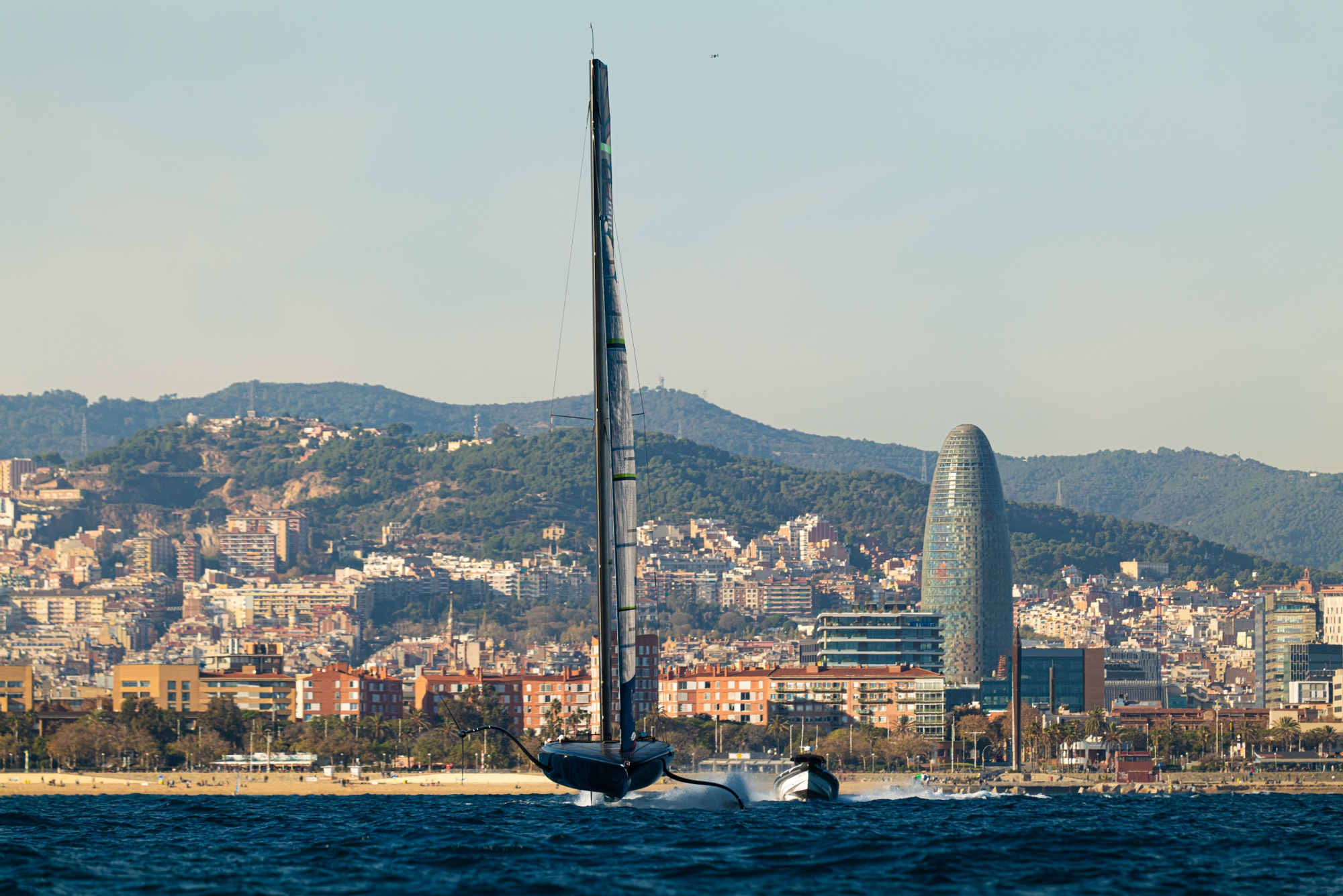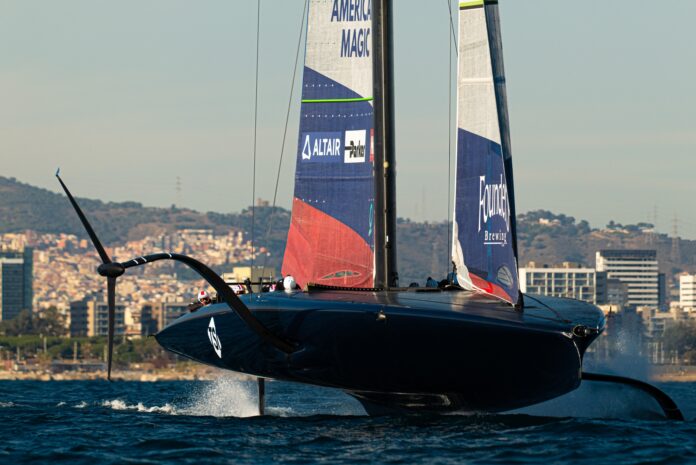Wasting little time since the America’s Cup Preliminary Regatta in Jeddah, the NYYC American Magic team re-assembled back in a chilly Barcelona where temperatures were some 10-14 degrees – a far cry from the 30+ experienced in Saudi Arabia.
The team looked excited to be getting back into Patriot, their AC75, after a series of unsaid upgrades had been installed down below as the team continues to push on with systems control development on this legacy yacht with the idea being to circumvent development time when the new boat arrives in the Spring.

However, one area where the team were struggling on in practice before Jeddah, with the mainsail getting pinned in tight as both the mainsheet and traveller stuck, was again a recurring theme of this light weather training day. Technicians came onboard twice to try and resolve the issue before the team could really get flying and put in some laps up and down the La Barceloneta America’s Cup racecourse.
The weather window was small for the team today with the forecast showing a small increase mid-afternoon to just touching double digits before dropping away into the evening. With the big J1 set for the first two hours, it was all displacement sailing and tow-to-fly runs behind the Chase Boat with minimal flight time whilst the mainsheet system problems persisted. At one point a crew-member sat in front of the rudder gantry to inspect the system whilst in flight and it was clearly a concern.

When the wind came up, Patriot could at last take-off on her foils without assistance and the team swapped down two codes and put up the J3 for the last hour of sailing around laid courses. There’s still very much a sense of re-commissioning going around this AC75 at the moment and in flight the trimmers were opting for a flat to, slightly uncomfortable looking, leeward heel angle whilst Tom Slingsby and Paul Goodison were steering quite wide angles out of the tacks to keep flow over the foils and stay in flight. Good round-ups were observed and all in all it was another solid day in the books for the Magic team.

Speaking afterwards, Riley Gibbs the much-admired trimmer who wasn’t actually on the boat today, spoke to the recon team, saying: “We had a fairly small window of breeze and tried to make the most of the opportunity, obviously you know coming back from Jeddah and whatnot just trying to capitalise on the gains that the team’s been able to make in the shed and really put those to the test on the water… I guess it all comes down to putting it together on a racecourse, so you saw us out there going around marks and just going through different systems and functionality and priorities.”

And Riley continued: “We’ve made nice inroads for sure since our first week on the water…we’re always going to try and make progress so you’ll see examples of that on the water, we might not make a manoeuvre here but we’ll improve elsewhere and so on, so yeah just fundamentally through the team we’re always trying to make improvements and it’s how you go about those that really define the team and the group as a whole.”
NYYC American Magic will be back on the water tomorrow (Thursday) and are then next scheduled to sail on Monday next week. (Magnus Wheatley)
On-Water Recon Report – NYYC American Magic: The American team made the most of a narrow weather window today with a forecast that called for sub-six knot winds early in the afternoon that were predicted to rise to a peak of nine knots later before fading away again as sunset approached.
That forecast turned out to be pretty accurate, meaning that the Patriot crew – having docked out at just before 1230 – were able to hoist sails around two miles from the harbour entrance in flat water. The MN8-1 mainsail and the J1-6 headsail were hoisted shortly after 1300 and the boat was sailing in displacement mode in 4-6 knots of breeze by 1310.
After a couple of displacement tacks the American AC75 was put on a bow tow at 1317 and was quickly airborne and sailing at around 30 knots upwind. However, this first flight lasted only three minutes before the boat touched down during an attempted tack and stopped with the mainsail looking to be pinned by both the mainsheet and the traveller – a repeat of a previous issue from the last week of sailing. After 10 minutes of work by a technician below decks the mainsail issue was resolved.
A second tow up attempt at 1337 was aborted before the boat could take flight. The third tow up at 1345 was more successful and the boat was quickly up on its foils and headed into a developing 7-9 knot breeze. This flight lasted 5 minutes before the boat rounded up from downwind, tacked and stopped with the mainsail appearing to be pinned once again.
The issue took 10 minutes to resolve before the boat was back up at 1400 for a six-minute flight that ended with a touchdown tack and stop. A technician came onboard briefly before the boat was towed up at 1410 for a flight lasting 35 minutes (with one brief touch and go fall off the foils downwind) during which the crew began practice laps around a laid course made up of a windward and leeward gate. With the wind spiking up to 9-10 knots a stop was made at 1450 for a cyclor rotation and a headsail change to the J3-6.

The boat was up on foils (self-take-off) at 1505 for a flight lasting 25 minutes that included a downwind touchdown and a touchdown tack, both were followed by quick self-take-offs). After a tow up at 1545 in 6-7 knots of wind, we saw the crew practising light wind tacks with three touch and go tacks completed on the way back to the harbour entrance. Time was called at 1554 and the boat was back on the dock at 1625.






